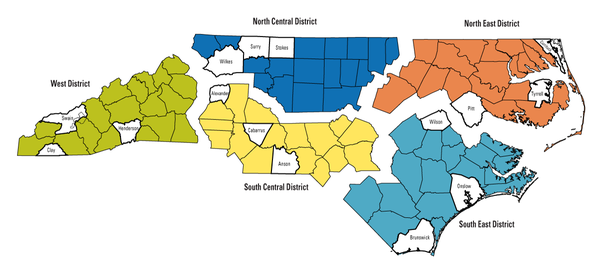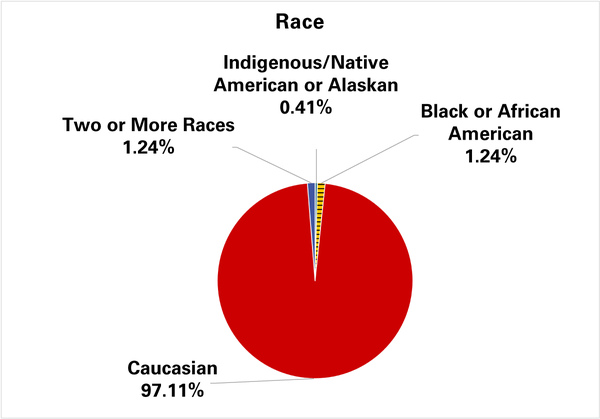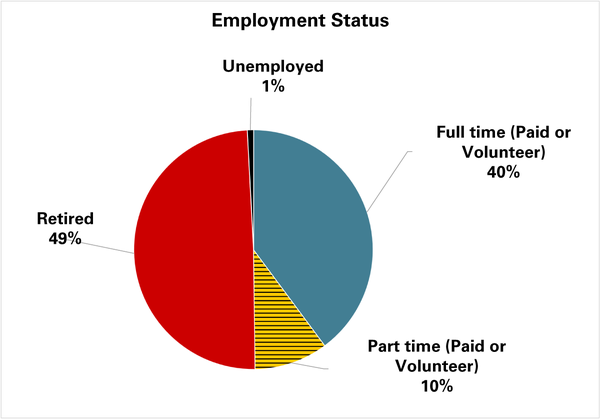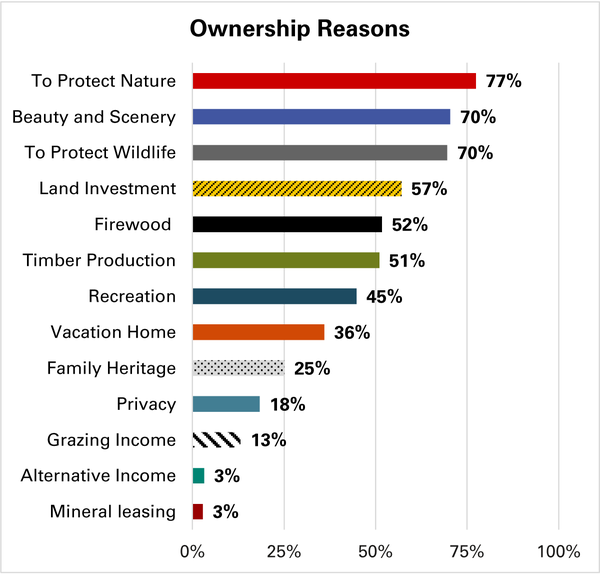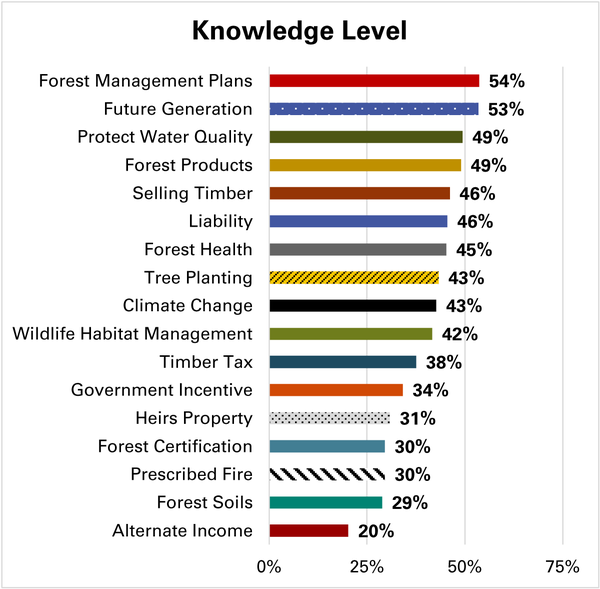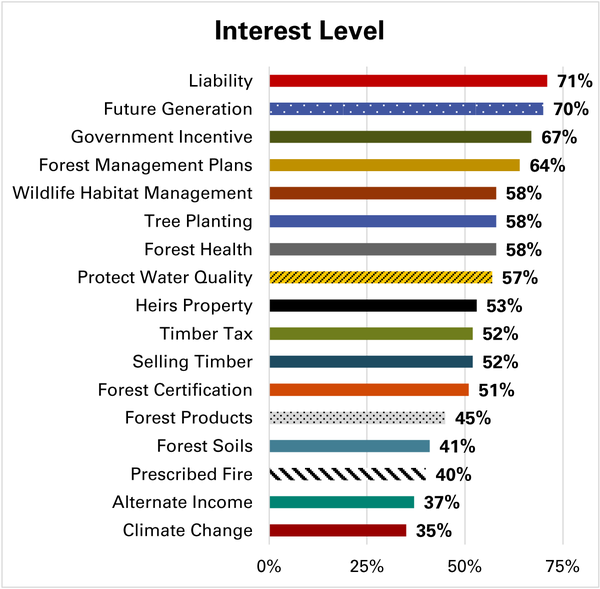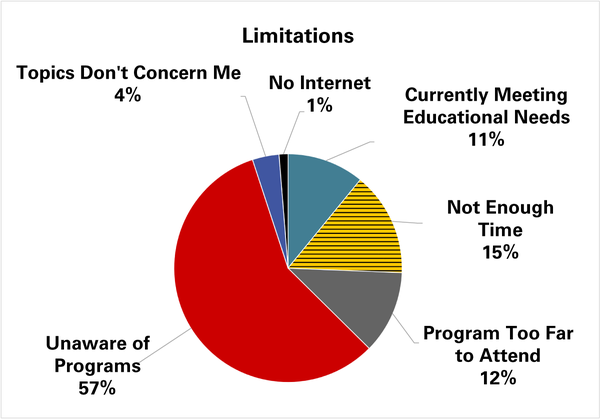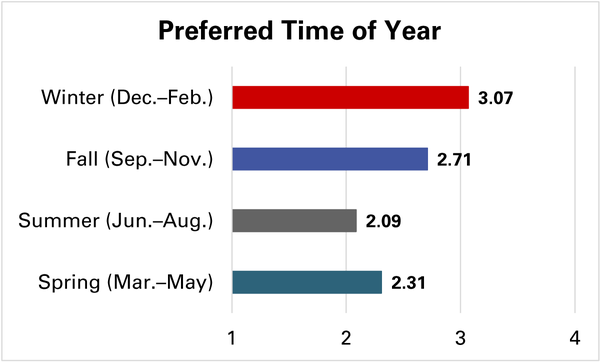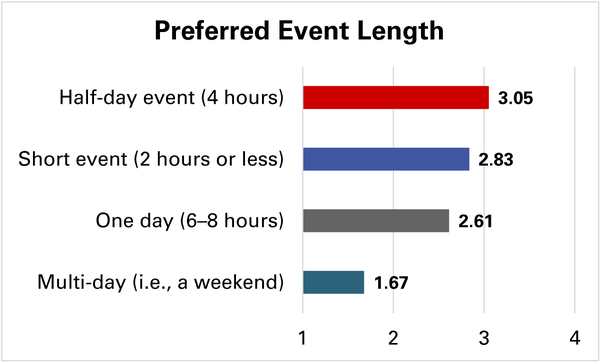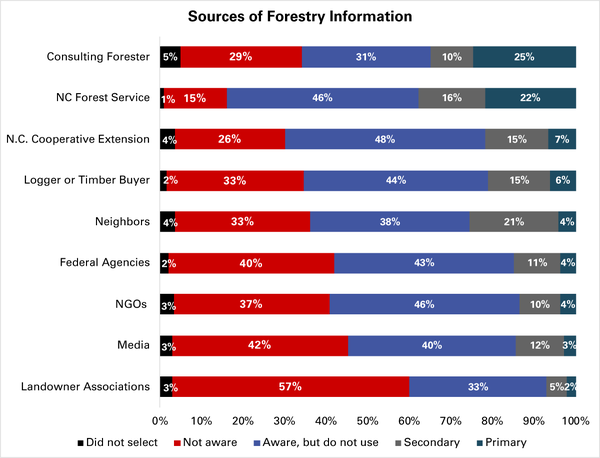Introduction
Forests and woodlands provide environmental, economic, and social benefits to their owners and nearby communities. In North Carolina, over three-quarters of approximately 18.7 million acres of forestland are owned and managed by over 525,000 non-industrial private forest (NIPF) landowners (Bissette and Arney, 2020). These private forest and woodland owners are the stewards of these forests, and in order to effectively manage them, it is important for them to be knowledgeable about the various aspects of forest and forest management. To facilitate effective educational programs for NIPF landowners, agencies and organizations must have a better understanding of the educational needs of these landowners. To do this, NC State Extension Forestry conducted an educational needs assessment of North Carolina’s NIPF owners in 2020.
Purpose
The needs assessment was designed to gauge North Carolina’s NIPF landowners’ needs related to training in forestry. Objectives of the assessment were to:
- Identify learning gaps in NIPF landowners’ knowledge to design effective educational programs,
- Identify any barriers for NIPF landowners in terms of meeting their educational needs, and
- Identify the educational program and information preferences of NIPF landowners to better reach and engage with this target audience.
Methodology
A survey was conducted among 3,000 NIPF landowners equally distributed across 15 North Carolina counties. These counties were selected using a stratified random sample of all 100 counties distributed between five Cooperative Extension districts (Figure 1). Three counties were selected in each district, with at least one being urban, one rural, and all three representing NC Department of Commerce’s three economic tiers of distress. Landowners were randomly selected from county parcel data obtained from North Carolina’s OneMap, an online geodatabase. To be eligible to participate, landowners had to own at least 20 acres of forestland.
The survey utilized for the assessment was developed with support from the NC State Extension State Program Leader for Extension Evaluation, tested with NIPF landowners, and approved by NC State University Institutional Review Board for the Protection of Human Subjects in Research. The survey was an internet-based survey administered through Qualtrics, with an option to complete a printed version of the survey. The survey was administered over a six-week period in June and July 2020, with landowners being notified by mail. Reminder cards were mailed after approximately two and five weeks following the initial notice of the survey.
Data analyses were performed using Microsoft Excel. The survey included questions on socio-demographics, general land ownership, educational limitations, knowledge and interest in various forestry topics, and educational program and information preferences.
Findings
The overall response rate for the study was 9.3%, or a total of 281 returned surveys. Of the 281 returned surveys, 242 respondents fully answered the questions on land ownership reasons, knowledge, and interest in forestry topics. The 281 responses were utilized in summarizing general demographics and landowner comparisons.
Findings in this needs assessment are similar with the outcomes from previous studies conducted of forest landowners in North Carolina, educational needs assessment of southern forest landowners, and the National Woodland Owner Survey (Bardon, Hazel and Miller, 2007; Measells et al., 2006; USDA Forest Service, 2021). Similarities in landowner socio-demographics and reasons for owning land across the studies indicate that this study’s findings are applicable to NIPF landowners in North Carolina who own 20 or more acres of forestland.
The Landowner
In general, NIPF landowners are older white males who have achieved a college degree or higher. Most of them have an income greater than the state median income of $54,000. Having a fairly high income level could be an indicator of discretionary income available for investment in managing their forestland. Nearly half of the respondents indicated being retired. Approximately three out of four respondents considered themselves somewhat engaged in the management of their forest land. An engaged landowner is defined as one who seeks knowledge about forestry; implements forestry practices such as timber harvesting, wildlife habitat improvement, or other activities; and may use technical assistance to achieve their goals. An unengaged landowner is defined as one who is aware of owning wooded land, but does nothing related to forestry or the management of their land.
A summary of the respondents’ demographics follows:
- Race (as self-identified): 97.1% Caucasian, 1.24% Black or African American, 1.24% Indigenous or Native American, and 0.41% two or more races (Figure 2).
- Age: The average age of respondents was 66, the youngest being 24 years and the oldest being 104 years.
- Gender: 76% of respondents identified as male and 22% identified as female; 2% declined to indicate.
- Employment Status: 49.38% retired, 39.83% employed full-time, 9.96% employed part-time, and 0.83% unemployed (Figure 3).
- Income Level: 46% of respondents reported annual income between $50,000 and $149,999; 37% reported income over $150,000, and 17% reported income under $50,000.
- Education Level: 37% reported attaining a bachelor’s degree, while 36% attained an advanced degree. Of the remainder, 12% had completed some college, 8% attained a high school degree, 7% earned an associate degree, and less than 1% did not complete high school.
- Level of Engagement: Almost half of respondents (48%) considered themselves engaged landowners, while almost a third (28%) considered themselves only somewhat engaged.
Land Ownership
Acres Owned and Land Tenure
NIPF landowners who responded to the survey own significant amounts of forestland, 289 acres on average (with a range of 8 to 15,000 acres) and have owned their land for an average of 25 years out of a range of 1 to 150 years.
Ownership Type
About 54% of the respondents indicated that they purchased their land, while 42% inherited theirs and the remaining 4% acquired the land by other means. Joint ownership among the landowners is prevalent (73%), commonly as joint owners (58%) or through a partnership or trust (15%).
Ownership Reasons
NIPF landowners were asked about the following reasons for owning forestland: to protect nature, beauty and scenery, to protect wildlife, land investment, firewood, timber production, recreation, vacation home, family heritage, privacy, grazing income, alternative income, and mineral leasing. Most of the respondents place a higher value on the intrinsic values for owning land, such as nature (77%), beauty and scenery (70%), and wildlife (70%), over other values of owning land, such as land investment (57%), timber production (51%), or other financial motives (Figure 4).
Distance from Forestland
Nearly 60% of NIPF landowners live on or within 30 minutes of their land while 29% live more than an hour away.
Educational Gaps and Barriers
Meeting landowners’ educational needs requires an understanding of their current knowledge and interest in various forestry topics and identifying the limiting factors in meeting these educational needs. Respondents were asked about the following topics: alternate income, forest soils, prescribed fire, forest certification, heirs property, government incentive, timber tax, wildlife habitat management, climate change, tree planting, forest health, liability, selling timber, forest products, protect water quality, future generation, and forest management plans.
Knowledge Level
The majority of respondents indicated having basic-to-advanced knowledge on two of the 17 topics presented, forest management (54%) and plans for passing the land on to the next generation (53%) as shown in Figure 5. For the remaining topics, a limited number of the respondents indicated having basic-to-advanced knowledge on alternate income (20%), forest soils (29%), prescribed fire (30%), forest certification (30%), heirs property (31%), government incentive (34%), timber tax (38%), wildlife habitat management (42%), climate change (43%), tree planting (43%), forest health (45%), liability (46%), selling timber (46%), forest products (49%), and protect water quality (49%) as shown in Figure 5.
Interest Level
Most of these landowners indicated a moderate to extreme interest in a wide variety of forestry topics, with the greatest interest related to landowner liability (71%), passing the land on (70%), government incentive programs (67%), and forest management plans (64%) as shown in Figure 6. Figure 6 also shows that the majority of respondents indicate a moderate to extreme level of interest in wildlife habitat management (58%), tree planting (58%), forest health (58%), protecting water quality (57%), heirs property (53%), timber tax (52%), selling timber (52%) and forest certification (51%). For the remaining topics, Figure 6 shows a limited number of respondents have a moderate to extreme interest in forest products (45%), forest soils (41%), prescribed fire 40%, alternative income (37%) and climate change (35%).
Limitations
Most respondents (57%) indicated that not being aware of educational programs is the main reason limiting them from meeting their educational needs related to forestry (Figure 7). Other limitations included not enough time (15%), program too far to attend (12%), currently meeting educational needs (11%), topics are not of concern (4%), and no internet (1%).
Educational Program Preferences
Respondents indicated their greatest preference is for participating in educational events that take place in the winter months and occur during the day (Figure 8 and Figure 9). They prefer to attend educational programs that are 4 or fewer hours in length (Figure 10). A majority (71%) are willing to travel outside their county and an average of 87 miles to attend educational programs.
Educational Information Preferences
To reach North Carolina’s NIPF landowners, it is important to know how they prefer to receive their information and who they go to for forestry information. The majority of responding NIPF landowners prefer to receive information via mailed materials followed by online materials. They are as likely to prefer online programs as in-person programs. Respondents predominately utilize broadband internet, with the majority of them using either computers or mobile phones as their gateway to the internet.
Material Preference
- Mailed Materials: 69.8% prefer receiving brochures and factsheets.
- Online Materials: 64.9% prefer receiving materials such as websites and social media.
- Online Programs: 57.4% prefer videos, seminars, and self-paced course content.
- In-person Programs: 54.5% prefer attending lectures, workshops, and field trips.
Internet Access
- 8 out of 10 respondents use broadband to access the Internet.
- 3 out of 10 respondents utilize cellular service to access the Internet.
- Satellite (6.6%) and dial-up (2.1%) are the least-used methods for accessing the Internet.
- A small percentage (6.2%) of the respondents do not have Internet access.
Device Used to Access Internet
- 8 out of every 10 respondents access the Internet utilizing a computer.
- 6 out of every 10 respondents access the Internet utilizing a cell phone.
- 4 out of every 10 respondents access the Internet utilizing a cell tablet.
Sources of Forestry Information
NIPF landowners were asked about their awareness and utilization of the following sources of forestry information: consulting foresters, the North Carolina Forest Service, N.C. Cooperative Extension, loggers or timber buyers, neighbors, federal agencies, non-governmental organizations, media, and landowner associations and the results are shown in Figure 11.
Responding NIPF landowners indicated consulting foresters (25%) and the North Carolina Forest Service (22%) are their primary source of information. Other primary sources of information as shown in Figure 11 include N.C. Cooperative Extension (7%); loggers or timber buyers (6%); neighbors, federal agencies, and non-governmental organizations (4%); media (3%); and landowner associations (2%).
Secondary sources of information include neighbors (21%), NC Forest Service (16%), N.C. Cooperative Extension and loggers or timber buyers (15%), media (12%), federal agencies (11%), consulting foresters and NGOs (10%), and landowner associations (5%).
Many of the responding landowners indicated that they are aware of, but do not use N.C. Cooperative Extension (48%), NC Forest Service and NGOs (46%), loggers or timber buyers (44%), federal agencies (43%), media (40%), neighbors (38%), landowner associations (33%), and consulting foresters (31%).
A majority of respondents were least likely to be aware of forest landowner associations (57%). A majority (57%) of respondents indicated not being aware of landowner associations as a source of forestry information. Figure 11 also indicates a limited number of respondents were not aware of the following sources of information: media (42%), federal agencies (40%), NGOs (37%), neighbors and loggers or timber buyers (33%), consulting foresters (29%), N.C. Cooperative Extension (26%), and NC Forest Service (15%).
Conclusion
Acknowledging the differences and associations between core landowning values, characteristics, and educational preferences will allow for the continual improvement of programs and ensure that educational needs are being met. Using targeted delivery methods and forestry topics allows for a more effective and efficient process, ultimately creating more room for growth and engagement.
The majority of NIPF landowners are interested in non-timber-related topics, prefer short educational programs that take place in the winter, and equally prefer mailed or online materials.
The main reason the majority of NIPF landowners do not have their educational needs met is the lack of awareness of available programs. This lack of connection with NIPF landowners will be a challenge for organizations, such as Cooperative Extension, and will require a consorted effort to overcome. More aggressive and innovative efforts in marketing programs will be necessary to meet the educational needs of NIPF landowners. Since the majority has access to the Internet and prefer to receive forestry information over the Internet, it is important to develop online education programs as an innovative strategy to reach NIPF landowners and serve their needs.
To reach out to NIPF landowners on a broader scale, a combination of mail and electronic delivery methods, such as email or social media, should be prioritized on a variety of topics. When training topics are selected, it is important to select the topics that have a higher level of importance to this audience, and a lower level of knowledge for contributing to meet their learning needs. Online delivery options should include the use of newsletters, blogs, or social media as ways to reach the audience.
References
Bardon, R., Hazel, D. and Miller, K. 2007. Preferred information delivery methods of North Carolina forest landowners. The Journal of Extension, 45(5).
Bissette, S. and Arney, K. 2020. North Carolina State and Private Forestry Fact Sheet 2020.
Butler, Brett J. and Butler, S. M. 2016. Family forest ownerships with 10+ acres in North Carolina, 2011–2013. Res. Note NRS-230. Newtown Square, PA: U.S. Department of Agriculture, Forest Service, Northern Research Station. 2 p.
Measells, M. K., Grado, S. C., Hughes, H., Dunn, M. A., Idassi, J. O. and Zielinske, R. J. 2006. Educational needs of southern forest landowners. The Journal of Extension, 44(5).
USDA Forest Service. 2021. Family forest (10+ acres) ownership characteristics: North Carolina, 2018. US Department of Agriculture Forest Service Northeastern Forest Experiment Station, 290(), 1–2.
Acknowledgment
This publication is funded in part by the Renewable Resources Extension Act (RREA).
Publication date: April 20, 2022
AG-912
N.C. Cooperative Extension prohibits discrimination and harassment regardless of age, color, disability, family and marital status, gender identity, national origin, political beliefs, race, religion, sex (including pregnancy), sexual orientation and veteran status.

